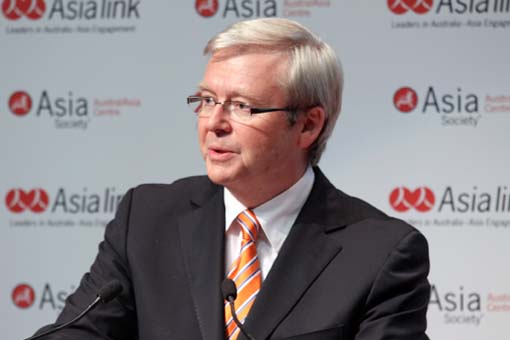‘Regional architecture’ is often discussed in the language not of the architect but of the engineer: a language of interlocking mechanisms, instruments, functional needs, design faults and structural untidiness (to cite some terms used in recent writings). The real architect prefers a more holistic, grounded vision – integrating structures within their environmental and sociological contexts. Designing institutions to address practical, transnational problems makes sense. In counter-terrorism, organised crime, trade facilitation, health security and many other areas, there are increasing numbers of issues that require inter-state cooperation – something that is often achieved more easily on a regional rather than a global scale.
The Australian Prime Minister expressed a functionalist view of regionalism when he proposed an Asia Pacific Community in 2008. He suggested it was necessary to establish a community with a ‘regional institution that spans the entire Asia-Pacific region’ and ‘is able to engage in the full spectrum of dialogue, cooperation and action’ on economic, political and security issues. But in a less frequently quoted sentence – one more sociological or architectural in its concerns – he also stressed the need to develop a ‘genuine and comprehensive sense of community’.
Bringing about a real regional community, as many at the Asialink Forum argued, is a demanding task: it means serious engagement in the region’s art world, developing regional research collaboration, bringing about large-scale student exchange schemes, and building health and disaster-relief networks. It also means fostering a sense of ‘We-ness’. In Australia’s case all of these objectives would require a huge advance in our national community’s Asia literacy.
How the terms ‘region’ and ‘regional community’ are understood in Asian countries is something requiring close attention. In some cases, thinking about community seems to involve notions (often vague) of family sentiment, or at least the suggestion of some common historical experience, and of that feeling of ‘We-ness’. It seems significant that recently departed Japanese Prime Minister Hatoyama invoked the Asian/Western opposition when advocating his East Asian Community. In what sense is his community to be Asian? Defining the region is one obvious area in which sociological and cultural substance matters. An important question for Australians concerns how the idea of an Asia-Pacific region is understood in different parts of Asia: what it means for them to belong to such a community? Does the term ‘Asia-Pacific’ possess any potential emotive resonance in Asian societies?
Australia has been promoting Asia Pacific architecture for decades – going back to the Asia-Pacific Economic Cooperation, which commenced in 1989, the Pacific Economic Cooperation Conference (1980), the Organisation for Pacific Trade and Development (advocated through the 1970s), and the Asian and Pacific Council (founded in 1966). Insisting on an Asia-Pacific scope makes sense for Australia; it signifies a regionalism in which the United States and other non-Asian Pacific states, including Australia, can be influential insiders. Australia and the Australia-United States alliance fit comfortably here. Advancing Asia Pacific architecture, however, has often been a tough task. It must compete with the more narrow East Asian (or sometimes Asian) form of regionalism present, for instance, in the formation of the Association of Southeast Asian Nations in 1967, in Malaysian Prime Minister Mahathir’s advocacy of an East Asian Economic Caucus in the early 1990s and the establishment of ASEAN + 3 (plus China, Japan and the Republic of Korea) in 1997. The last decade or so has been especially difficult for APEC – with its loss of prestige during the Asian financial crises of 1997-1998, and the damage done to the United States in the Global Financial Crisis and Iraq. Chinese success, by contrast, has helped to drive the East Asia project.
What are the prospects for Australia in this alternative regional venture? It is a venture that has at times demonstrated a capacity for openness. It happens that Australia was involved in the Asian Relations Conference back in 1947, and in 1974, Australia became ASEAN’s first Dialogue Partner. Foreign Minister Evans was praised for being sensitive to Asian viewpoints in the early 1990s, in his efforts to promote a broad security organisation, which became the ASEAN Regional Forum. Australia’s last Coalition government responded with warmth to the creation of ASEAN + 3, recognising its Asian ownership. That grouping then demonstrated the East Asian potential for inclusiveness by initiating the East Asia Summit in 2005, and inviting Australia (along with India and New Zealand) to join.
The issue to consider now – if we are true institutional architects and not mere engineers – is whether regional objectives will be advanced best by the continued advocacy of Asia-Pacific projects, or by an attempt to align Australia more closely with East Asia regionalism. Each course is challenging and they both require us to understand that regionalism is only partly about achieving structural tidiness in economic and security cooperation.
Anthony Milner is Basham Professor of Asian History at ANU and Professorial Fellow at the University of Melbourne.


Professor Milner proposes a false choice for Australia in its approach towards developing regional architecture that serves our national objectives of participation in Asian Community building and managing our Asia-Pacific cooperation interests. He says that the issue to consider now – if we are true institutional architects and not mere engineers – is whether regional objectives will be advanced best by the continued advocacy of Asia-Pacific projects, or by an attempt to align Australia more closely with East Asia regionalism.’ We can and need to pursue both national objectives. Does he believe they are incompatible? His essay is delightfully vague on that and all the important policy questions about this matter. Each course is indeed challenging and they both need to be pursued for substantial reasons not because they are motivated by achieving structural tidiness in economic and security cooperation. On Professor Milner’s metaphor that extols the virtues of architects compared with engineers, as anyone familiar with the history of trying to build the Sydney Opera House must know, the virtues of each profession would seem to be not independent of each other.